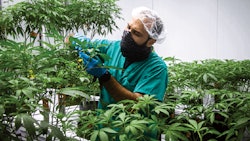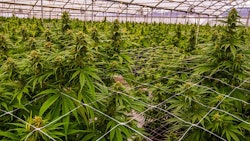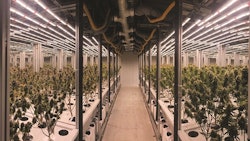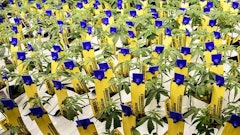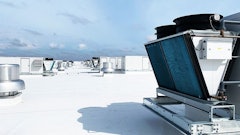
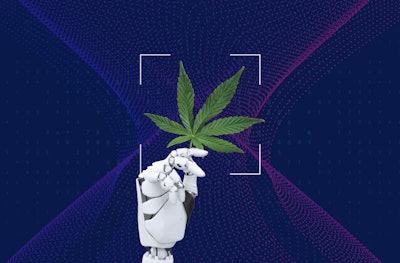
When Rich Kwesell and his brother Mike started Strawberry Fields in 2009 with three plants growing in a spare bedroom, every aspect of cannabis production was done manually. As their operation evolved into to a vertically integrated operation—including five Strawberry Fields dispensaries in Colorado and the Heartland Industries wholesale brand—they slowly have automated practically every production process along the way.
In the early days, Strawberry Fields’ employees pumped two-gallon, garden-variety spray cannisters to apply pest controls. “It would take two people eight hours to apply a whole greenhouse,” Kwesell says. “That was one of the first things that we automated. We started upgrading our applicators from $10 sprayers to a $7,500 bio fogger [that’s] basically a bazooka. Now, that’s obsolete, and we use stationary foggers throughout the house that apply biocontrols.”
What once took two employees a full work day now takes one person less than half an hour—and can even be programmed overnight without employees on-site.
Other equipment like automated pot fillers, irrigation systems, conveyors, and climate controls add valuable efficiencies throughout the production process. These technologies have enabled cannabis cultivators like Strawberry Fields to scale efficiently while expanding operations across multiple states.
“[We’re] huge on trying to automate the process as much as possible, simply because we have to make payroll with cashflow every two weeks, or we’re out of business,” Kwesell said during a panel presentation at Cannabis Conference 2021. That said, with cashflow always a factor, Kwesell added, “You’ve got to really think before you spend a huge amount of money on automation.”
A streamlined approach to cultivation comes at a cost, so weighing these considerations is a critical step before investing in automation. Here are some of the key factors to evaluate as you calculate the return on investment (ROI) of automation in your cannabis grow.
Reducing the Labor Strain
For cultivation operations struggling to hire employees to perform repetitive cultivation tasks such as watering plants and applying nutrients, automation can become increasingly appealing. In fact, Kwesell says, labor challenges and rising payroll costs are often the first sign that growers should explore automation—plus, this area typically offers the biggest potential to reap significant savings.
When considering automated equipment, “The first major criteria is payroll,” Kwesell says. “Payroll is our largest [budget] line item, so we always try to look at those processes in our flow that require the most labor and try to offset that labor.” When Kwesell paid employees to spend hours spraying the greenhouse, for example, “their payroll went directly against my cost to produce that pound. Once you start adopting automation, you immediately attack your payroll and start realizing the savings.”
The sheer number of people it would take to water 25,000 outdoor-grown plants at Christina Lake Cannabis Corp. (CLC) made manual irrigation practically impossible, so the British Columbia-based licensed producer (LP) built its operation around technology and invested approximately $25 million over several years. The team knew its investments would quickly offset the costs and hassles associated with hiring.
“Since day one, we realized that, for the scale of our project, there was no way we could do it without automation,” says Nicco Deehan, CLC’s COO and master grower. “Our irrigation system is fully automated, so one person can run the irrigation for 25,000 plants. Whereas, if you were doing it manually, it’d be hard for a grower to [water] much more than 500 plants in a day, so you’d need 30 to 50 people out there hand-watering. It would be a nightmare.” CLC’s automated drip irrigation system doubles as a nutrient injector that growers can program to schedule fertigation across 20 acres of outdoor cultivation.
CLC also uses automation to monitor plant health and hydration using an infrared drone that cost around $10,000, with a monthly software subscription of $250. The drone technology identifies underwatered or overwatered plants, chlorophyll levels, growth rates, and signs of stress, so growers can take a targeted approach to address issues before they erupt into widespread problems.
“If we had to have people out in the field, walking row to row, checking every individual plant, it would be a massive amount of manpower—and it would be very difficult to staff that,” says Joel Dumaresq, CEO at CLC.
These technologies enable CLC to staff its entire 20-acre production with just five growers, plus a field crew of 10 seasonal full-time workers. According to Deehan, leaving tedious tasks to the machines not only allows employees to focus on higher-value jobs, but also boosts productivity and improves yield.
“Automation allows the growers to spend more time on the things the plants need to achieve optimum results,” Deehan says. “Instead of holding a water wand, they can be looking at genetics, taking clones, identifying deficiencies, and harvesting.”
Shifting labor from repetitive tasks to more intensive cultivation jobs also can motivate your workforce.
“You’re gaining the ability to use those people in more important areas,” Kwesell says. “Anything I can do to move quality people up the line so they’re handling more volume and more responsibility [increases their value]. It also helps that person’s morale and outlook tremendously because it helps them realize this is a career.”

Gaining Unmatched Consistency
Compared to manual labor, automation offers unmatched consistency in tedious production tasks like watering and temperature control. These consistencies can unlock massive economies of scale for growers while achieving the quality levels that customers expect. That’s why consultants like Andrew Lange, whose firm has completed more than 2 million square feet of indoor cultivation design across eight countries, rely heavily on automation to achieve scalable growth.
“If you have 20 different people watering your plants, regardless of how well-trained they are, you have 20 different results. Some plants are going to get too little water, some too much, and both of those affect yields, so now you have variability within your product,” says Lange, president of Ascendant Management. “A computer uses empirical data, so it knows when to water things exactly—and it never quits, gets sick, or takes the day off.”
Precise automated watering and nutrient feeding schedules contribute to plant health, Deehan says, which can maximize yields and improve the quality of the final product. It also gives growers tighter controls over application rates than the traditional “spray and pray” approach, ensuring that pricey nutrient solutions are actually being absorbed by the plants instead of going to waste.
“Our growers can monitor flow rates on their mobile devices and set alarms to avoid drought events,” Deehan says. “We can also watch runoff, which, on our scale, would cost about $35,000 per year, so we’ve got to be very cautious. We can even utilize the hours of the night to run programs, so we lose less to evaporation.”
Thanks to these efficiencies, CLC exceeded its inaugural production forecasts of 22,500 kilograms by more than 44% in 2020 with a yield of 32,500 kilograms of dried cannabis in 2020—with plans to increase production by at least another 35% this year.
Passing the Capacity Test
However, just because a piece of equipment promises to make employees more productive doesn’t necessarily mean it’s a sound investment. To balance the potential labor savings and increased efficiencies against the cost of automation, growers have to analyze how each machine would impact production processes.
For instance, Kwesell recently began evaluating automated transplanters after one caught his eye at a trade show. “Ultimately, the goal was to figure out: Does it make sense to spend 85 grand on an automated transplanter?” he says.
Based on the machine’s estimated throughput, the financials made sense for the Kwesells’ operation. Although financial projections are key to due diligence, it’s important to go beyond the numbers by evaluating automated processes in action.
“Do a lot of research,” Lange says. “Spend your time doing demos and visiting other facilities that run that equipment. Talk to the people who run it and make sure that the process will work for you—or that you can change your process to work for the automation. Otherwise, it’s a waste of money.”
For example, CLC’s cultivation team spent years testing individual drippers before installing the automated irrigation system. “Test it and test it again before implementing it, because if you take the wrong turn, it’s hard to recover,” Deehan says. “If you were to build out 20 acres of irrigation and find that your drippers can’t handle your [nutrient] solution, you’re absolutely screwed. Make sure it can handle what you’re trying to do.”
Part of gauging a machine’s true effectiveness, Kwesell says, is engaging the employees who would actually use it. After he interviewed and observed his team during several rounds of transplanting, Kwesell determined that they couldn’t use the machine he was eyeing to its full capacity. “We’re not doing the volume to justify a transplanter,” he says.
As a similar example, he says, an automated seeder might save your team a lot of time during planting season—but those machines are designed to plant hundreds of thousands of seeds per week. Unless your production volume can keep the equipment running all year, you likely will not maximize your ROI.
“We generally like to see [ROI within] nine months to three years, based on a worst-case scenario,” Kwesell says. “Don’t ever start with the best-case scenario—it never happens. Look at the worst-case scenario, at a bare minimum increase, what this equipment would do.”
To evaluate automation’s place in your production process, look ahead to understand how it might impact operations further down the line, most importantly: Will you be able to harvest, process, and sell all the cannabis you’re producing through automation?
“The biggest advantage is scale—you can produce an awful lot,” Deehan says. “The disadvantage is that you can get yourself into trouble because you can grow so much product with so little manpower, so you have to be careful that you have the resources to deal with that.”
Calculating Automation ROI
Ultimately, the underlying reason why growers automate cultivation processes is to drive down production costs to maintain margins in an increasingly commoditized market. In other words, the ROI of automation boils down to the bottom line.
“As commoditization occurs and you see lower pricing, you’ve got to rise to the occasion and find ways to get more efficient through additional equipment,” Dumaresq says. “To compete with indoor and greenhouse producers, we knew we had to commit to being among the lowest-cost producers, and that has driven a lot of our decision-making around automation. Large-scale automation allows us to price ourselves such that we can compete very effectively with the [illicit] market, which gives us a real advantage over our competition within the legal market.”
Dumaresq says CLC has raised approximately $25 million in capital to build out its fully automated facility over the past three years. Now, by the end of its second growing season this year, he expects the business to reach profitability.
Similarly, Kwesell says automation has been essential to lowering production costs at Strawberry Fields by cutting labor expenses while increasing efficiency. “By involving automation, we have probably cut down our costs from 2009 by maybe 75% or more,” he says. “Back then, we weren’t able to calculate our production costs like we are today, but we were probably over $500 to produce a pound in the beginning. Fast-forward to today, and we can get it under $100 if we need to.”
As margins continue to tighten and prices compress, investments in automation can reap huge returns through lower production costs and increased capacity. For many growers, like Kwesell, automation is critical to remain relevant and competitive in a maturing cannabis market.
“You’ve got to automate or die,” Kwesell says. “If I could have done it again, hindsight 20/20, I would have taken all these steps to automate sooner. I would have done it as fast as possible. You can drive yourself crazy looking at your analysis on each decision, but if we would have dove in quicker, we would’ve had a much bigger advantage.”
Brooke Bilyj owns and operates Bantamedia, a national award-winning content, SEO and PR firm based in Cleveland.







